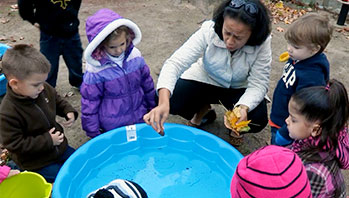- camera
- chalk
- clipboard
- containers of water
- ice cubes
- large house-painting brushes or rollers
- paper
- pen
- squeeze bottles
- evaporate
- puddle
- wet
MA Standards:
Language/L.PK.MA.6: Use words and phrases acquired through conversations, listening to books read aloud, activities, and play.
MA Draft STE Standards:
Earth and Space Sciences/Earth’s Systems/ESS2.A: Observe, investigate, and classify the non-living materials, natural and human made, in their environment.
Head Start Outcomes:
Logic and Reasoning/Reasoning and Problem Solving: Classifies, compares, and contrasts objects, events, and experiences.
Science Knowledge/Scientific Skills and Method: Collects, describes, and records information through discussions, drawings, maps, and charts.
Science Knowledge/Conceptual Knowledge of Natural and Physical Worlds: Observes, describes, and discusses properties of materials and transformation of substances.
PreK Learning Guidelines:
English Language Arts/Language 2: Participate actively in discussions, listen to the ideas of others, and ask and answer relevant questions.
Science and Technology/Inquiry Skills 2: Make predictions about changes in materials or objects based on past experiences.
Science and Technology/Inquiry Skills 4: Record observations and share ideas through simple forms of representation such as drawings.
Science and Technology/Physical Sciences 19: Explore, describe, and compare the properties of liquids and solids found in children's daily environment.
Explore Together (outdoors): Disappearing Water

© Commonwealth of Massachusetts, Department of Early Education and Care. All rights reserved.
STEM Key Concepts: Wet things become dry as the water evaporates (changes from a liquid to a gas)
ELA Focus Skills: Listening and Speaking, Vocabulary
Educator Prep: Prepare ice cubes ahead of time. You may want to put food coloring in the water so the ice cube paints are different colors.
This activity should be done on a day when the weather will allow an opportunity for water to evaporate. You can begin the activity and then bring children back outdoors to check on their “paintings” later in the day.
Tell children they are going to be painting with water and making puddles outdoors. Have children work in two groups. Assure them that each group will have an opportunity to do both activities (painting and tracing).
Painting group: Invite children to paint with ice cubes on the pavement or walls. Encourage them to paint in a sunny area and in a shady area.
Tracing group: Have children make puddles on different parts of the pavement––in the shade and in the sun. Then have them use chalk to draw a line around each puddle.
Ask, What do you think will happen to the paintings/puddles? Record their ideas.
Once children have finished both activities, gather them together. Explain that you want each child to go back to the first activity he or she explored. Say, If you were in the painting group first, then go back and observe what happened to your painting. If you were in the tracing group first, then go back and see what happened to your puddles.
As children explore, circulate and listen to what children are observing. Ask questions to extend their observations, such as,
- Which puddle is larger—the one in the shade or the one in the sun?
- What happened to the pictures you painted on the wall? Which ones stayed the same? Which ones changed? How did they change?
Have children draw a new chalk line around their puddles, and allow them to check back later in the day to see how their puddles have changed.
Encourage children to draw a picture of their puddles in their science notebooks. You may want to help children note the elapsed time (morning time, snack time, etc.) beside each of their drawings. As children draw, take photographs of the puddles to help them record their observations. Help them label their drawings so that it is clear which puddle was in the sun and which one was in the shade.
Reflect and Share
Once inside, have children share their observations and describe their drawings. Discuss children’s original predictions and compare them to the outcomes they documented in their drawings and photographs. Ask,
- Did some of your puddles evaporate faster than others? Why do you think that happened?
- Why do you think some of them disappeared? Why didn’t all of them disappear?
Display the photographs in the Science and Math Center so children can revisit them during their explorations with water and evaporation.
